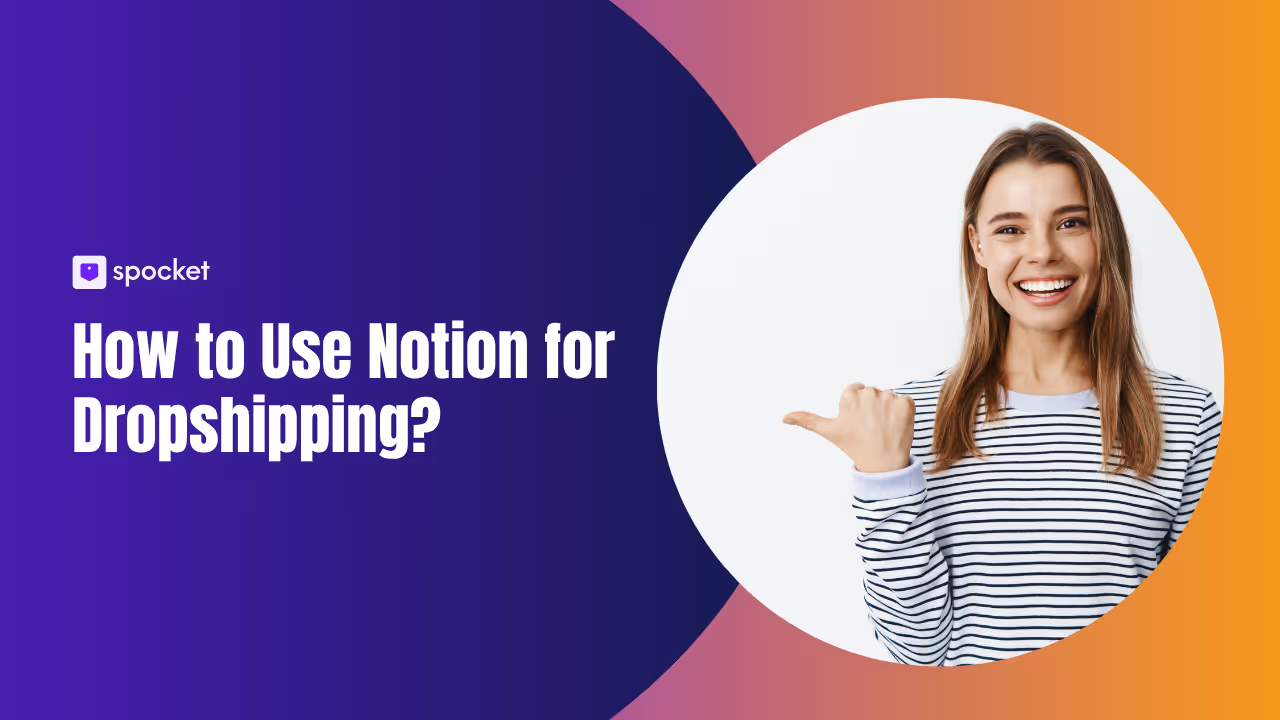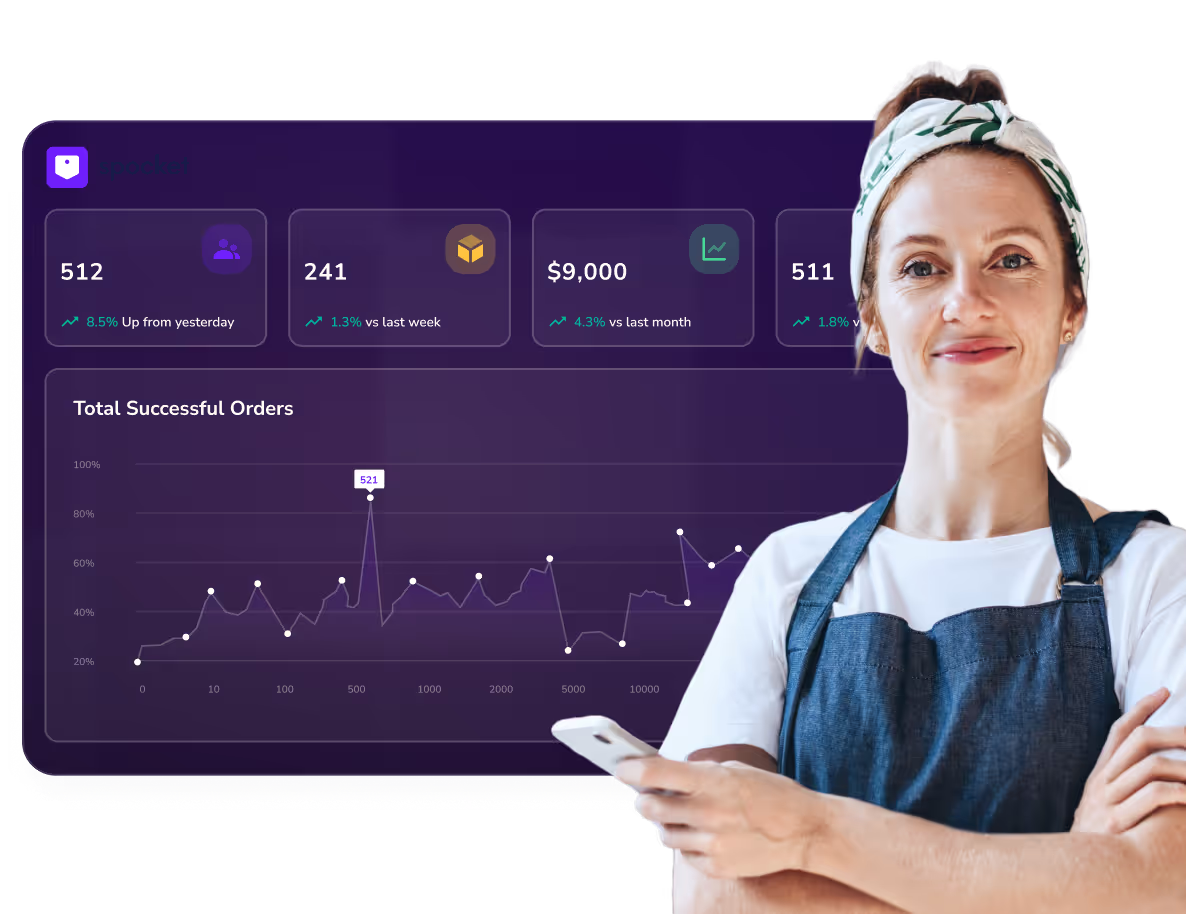Starting a dropshipping business is exciting, but one area that can often trip up newcomers is order fulfillment. At its core, fulfillment is the journey an order takes from when it’s placed to when it arrives on your customer’s doorstep. Sounds simple, right? Well, it’s actually a crucial part of your business’s success.
Without proper fulfillment, even the best products can be lost in the shuffle, leading to delayed deliveries, missed orders, and frustrated customers. And in the world of dropshipping, where you’re relying on suppliers to ship products directly to your customers, it’s easy to overlook how much this process can impact your reputation.
In this guide, we’ll walk you through the order fulfillment process, share strategies for keeping everything running smoothly, and give you the tools to avoid common pitfalls. Ready to dive in and get your fulfillment system on track? Let’s go!
What is Order Fulfillment in Dropshipping? Understanding the Fulfillment Process
Order fulfillment in dropshipping is a critical component of your eCommerce operations. While you’re not holding any inventory, it’s essential to know how the fulfillment process works, as it directly impacts customer satisfaction, shipping costs, and your business’s reputation.
In dropshipping, your role is to take orders and pass them onto suppliers who then handle the picking, packing, and shipping of the products. The success of your business depends on how quickly and efficiently your suppliers can fulfill these orders, so understanding this process is crucial for growth and profitability.
The Dropshipping Fulfillment Process: A Step-by-Step Breakdown
Understanding each step of the fulfillment process helps you manage expectations and identify opportunities to optimize. Let’s dive deeper into how it works:
Step 1: Customer Places an Order on Your Store
The first step in the dropshipping fulfillment process occurs when a customer visits your store and places an order. Whether they’re purchasing a product from your website or through an integrated marketplace, this initial action kicks off the entire fulfillment chain.
When a customer buys from your store, it’s essential to ensure their payment is processed quickly and that you confirm the order details promptly. The smoother this step, the better your overall customer experience will be.
Step 2: Order is Sent to the Supplier
After the order is placed, it’s time to forward the information to your supplier. This can happen manually, but automation is a game-changer here. If you’re using an automated platform like Spocket, the order is sent automatically to the supplier, which reduces errors and saves you time.
Automation in order forwarding eliminates human error and speeds up the fulfillment process by reducing delays. According to McKinsey & Company, businesses implementing automation in their fulfillment operations can see significant improvements in efficiency, with some achieving up to a 25% reduction in fulfillment costs and faster delivery times. This streamlining helps businesses meet customer expectations for quicker shipping and enhances overall operational performance.
Step 3: Supplier Picks and Packs the Product
Once your supplier receives the order, they pick the product from their inventory and prepare it for shipping. This is a critical step—effective packaging and proper handling ensure the product arrives in good condition.
Your dropshipping supplier should be prepared to handle products efficiently, ensuring minimal damage and maximizing the protection of the goods during transit. Suppliers who prioritize proper packaging are less likely to face return issues, improving the profitability of your store.
Step 4: Shipping and Delivery to the Customer
After the product is packed, it’s time for shipping. At this point, the supplier sends the product directly to the customer. Fast and reliable shipping is one of the biggest factors that influence customer satisfaction. According to recent consumer research, 42% of shoppers expect two-day shipping for every online purchase they make, highlighting how fast shipping can directly influence purchasing decisions.
Managing shipping speed is a delicate balance between cost and delivery time. As a dropshipping business, your goal is to provide affordable, timely shipping to your customers. Working with suppliers who have multiple shipping options can give you an edge in meeting customer expectations.
Why is Fulfillment Important for Dropshipping Businesses?
It’s easy to overlook the importance of fulfillment when you’re not physically handling the products. However, the fulfillment process can significantly impact customer satisfaction, business growth, and your bottom line.
1. Impact on Customer Experience
The way you handle fulfillment can make or break your customer experience. Shipping delays, poor packaging, and inaccurate tracking can result in negative reviews and lost customers. A smooth, fast, and reliable fulfillment process helps maintain customer trust and encourages repeat business.
According to recent consumer research, a significant majority of shoppers are less likely to repurchase from a retailer after experiencing delivery delays. For instance, a survey by Voxware found that 65% of consumers would abandon shopping with a retailer after two to three late deliveries.
Similarly, research by Radial indicates that 79% of consumers may not purchase again from a brand after a poor post-purchase experience, which includes delivery issues. These statistics highlight the critical importance of timely and reliable shipping in maintaining customer loyalty.
2. Building Trust with Fast and Reliable Fulfillment
One of the main benefits of mastering the fulfillment process is building trust with your customers. When customers know they can rely on you to deliver their products quickly and in good condition, they’re more likely to become repeat buyers.
Working with suppliers who offer fast shipping, trackable shipments, and reliable delivery times enhances the customer’s confidence in your store. Spocket, for example, gives you access to top-tier US/EU suppliers, ensuring faster delivery and reliable customer service.
Different Fulfillment Methods for Dropshipping Businesses
Choosing the right fulfillment method is crucial for the success of your dropshipping business. While the core concept of dropshipping remains the same, there are different ways to handle the fulfillment process that can impact efficiency, cost, and customer satisfaction.
In this section, we’ll compare the two primary methods—manual fulfillment and automated fulfillment—and discuss the pros and cons of each. We’ll also touch on how to select the method that best aligns with your business goals, supported by real-world data and practical tips.
1. Manual Fulfillment in Dropshipping: How It Works
Manual fulfillment involves the process of manually placing orders with your suppliers. After a customer makes a purchase on your store, you need to manually forward the order details to your supplier, who will then handle the rest.
Pros of Manual Fulfillment
- Greater Control: By manually managing orders, you can have more oversight into the entire process. You can communicate directly with your suppliers and ensure that each order is handled with care.
- Low Initial Setup Costs: Manual fulfillment doesn’t require sophisticated tools or platforms, so you can get started with minimal overhead.
Cons of Manual Fulfillment
- Time-Consuming: With manual fulfillment, you’re handling every order individually. This is time-consuming and can become unsustainable as your business grows.
- Higher Risk of Errors: Human error is a common issue in manual processes. Incorrect order details, missing items, or delayed communication with suppliers can lead to customer dissatisfaction.
- Scalability Issues: As your business grows, managing orders manually becomes increasingly difficult. This can result in delays, mistakes, and higher operational costs.
2. Automated Fulfillment: The Game-Changer for Dropshipping

Automated fulfillment is the future of dropshipping. It involves using software tools and integrations to automatically send customer orders to your suppliers as soon as the purchase is made. By automating this process, you eliminate the need for manual order forwarding, reducing human errors and speeding up the fulfillment process.
Pros of Automated Fulfillment
- Speed and Efficiency: Automated systems work quickly and without delay, ensuring that orders are processed and forwarded to suppliers immediately. This helps improve the customer experience by speeding up delivery times.
- Reduced Errors: Automation minimizes the chances of errors, such as incorrect order details or delayed processing. This leads to higher customer satisfaction and fewer complaints.
- Scalability: Automation allows your business to scale easily. Whether you’re processing 10 orders a day or 1,000, an automated system can handle the workload with ease.
Integrating automation into your dropshipping operations can significantly enhance efficiency and free up valuable time. For instance, Spocket offers automation tools that streamline processes like order fulfillment and inventory management, enabling online retailers to focus more on scaling their businesses and enhancing marketing efforts.
Similarly, other platforms have reported that automation can save entrepreneurs up to 20 hours per week, allowing them to dedicate more time to strategic activities. These time savings not only improve operational efficiency but also contribute to business growth and customer satisfaction.
Cons of Automated Fulfillment
- Initial Setup Costs: While automated fulfillment can save you time, it typically requires an initial investment in software tools or platforms. However, these costs are often outweighed by the long-term efficiency gains.
- Less Control: With automation, you’re relying more heavily on the systems and suppliers. While this reduces your workload, it can sometimes leave you with less oversight.
3. Hybrid Fulfillment Model: A Combination of Manual and Automated
Some businesses choose a hybrid fulfillment model, where they combine manual and automated methods depending on the situation. For example, they may use automation for most orders, but manually process high-ticket items or special requests that need extra attention.
Pros of Hybrid Fulfillment
- Flexibility: The hybrid model gives you the best of both worlds. You can automate routine orders, while still having control over more complex or custom orders.
- Balance Between Efficiency and Control: You can automate the high-volume tasks and manually oversee the important ones, allowing you to maintain flexibility and responsiveness.
Cons of Hybrid Fulfillment
- Increased Complexity: Managing two different systems can lead to confusion and requires more oversight. You’ll need to ensure both methods are synchronized and working efficiently.
- Higher Operational Costs: Balancing automation with manual processes can increase overhead costs if not managed properly.
Choosing the Best Fulfillment Method for Your Business
The fulfillment method you choose depends on several factors, including the size of your business, your resources, and your long-term goals. Here are some key considerations to help you decide:
1. Consider Your Business Size and Volume
If you're just starting out with a handful of orders, manual fulfillment may be fine. However, as your business grows, manual fulfillment becomes impractical and inefficient. When you start processing more than 30-50 orders per day, automation becomes crucial.
2. Assess Your Budget and Resources
Automation tools like Spocket can streamline the fulfillment process, but they do come with costs. Consider the tools and software that best align with your budget and operational goals. For instance, Spocket offers seamless integration with platforms like Shopify and WooCommerce, helping you automate order fulfillment without breaking the bank.
3. Evaluate Customer Expectations
If your customers expect fast, reliable delivery, automation is the way to go. Spocket provides access to suppliers who offer 1-3 day shipping within the US/EU, which can help you meet these expectations and improve customer satisfaction.
Key Challenges in Dropshipping Fulfillment and How to Overcome Them
While dropshipping offers numerous advantages, fulfillment challenges can quickly derail your business if not properly managed. Shipping delays, quality control issues, and inventory discrepancies are just a few of the hurdles that many dropshippers face. Understanding these challenges and having a plan to tackle them is essential for maintaining a smooth operation.
In this section, we’ll cover the most common fulfillment challenges in dropshipping and provide practical solutions to overcome them. With the right strategies in place, you can ensure your fulfillment process remains reliable, efficient, and customer-focused.
1. Shipping Delays and How to Overcome Them
One of the most common challenges in dropshipping is shipping delays. Since you’re relying on third-party suppliers to ship products, there’s always the risk of delays, whether due to stock issues, customs processing, or the supplier’s internal operations.
How to Overcome Shipping Delays
- Choose Reliable Suppliers: The most effective way to combat shipping delays is by partnering with suppliers who have a proven track record of timely delivery. Spocket, for example, connects you with US/EU suppliers who often offer faster shipping times compared to suppliers located overseas.
- Set Realistic Expectations with Customers: Transparency is key. Let your customers know about potential shipping times upfront. Consider offering express shipping options for customers who want faster delivery.
- Use Order Tracking: Using platforms that provide real-time tracking can help you and your customers stay informed about the status of the order. This can help ease frustration in case of a delay, as customers are aware of the situation.
2. Inventory Management Issues and How to Avoid Them
In dropshipping, inventory management can be tricky because you don’t have direct control over stock levels. A supplier running out of stock without your knowledge can lead to backorders and canceled orders, frustrating your customers.
How to Overcome Inventory Management Issues
- Automated Inventory Updates: Use platforms like Spocket that offer real-time inventory updates to ensure you’re aware of stock levels. This reduces the chances of selling out-of-stock products.
- Diversify Your Supplier Network: Relying on one supplier increases the risk of running into stock issues. Having multiple suppliers for the same products gives you more flexibility and minimizes the risk of a stockout.
- Set Up Back-In-Stock Notifications: Enable back-in-stock alerts for customers when a product is out of stock. This ensures you don’t lose a sale when an item becomes available again.
3. Quality Control and Product Issues
With dropshipping, you have no direct interaction with the products being sold. This means that any issues with product quality, packaging, or accuracy can only be addressed after they’ve already reached the customer. Poor product quality can damage your reputation and lead to returns.
How to Overcome Quality Control Issues
- Vet Suppliers Carefully: Work with trusted suppliers who maintain strict quality control standards. Spocket allow you to review suppliers’ ratings, ensuring you select the best quality products.
- Order Samples: Before listing a supplier’s products in your store, order samples to check the quality firsthand. This way, you can be sure you’re delivering a great product to your customers.
- Offer a Hassle-Free Return Policy: When dealing with product issues, having a transparent return policy in place can help smooth over customer complaints. Make sure your suppliers also have a flexible return policy to handle returns efficiently.
4. Customer Service and Communication Breakdowns
According to communication statistics, effective communication is key in dropshipping, especially when something goes wrong. Whether it’s an order delay, a product issue, or a return request, how you handle customer service can impact customer retention.
How to Improve Customer Service Communication
- Proactive Communication: Don’t wait for customers to chase you down about order issues. Proactively update them on order status, shipping delays, or product availability.
- Automated Notifications: Set up automated notifications for order confirmations, shipping updates, and delivery confirmations. This keeps customers informed and reduces anxiety around their orders.
- Streamline Customer Support: Use customer service software or tools to centralize communication. Having a smooth system for handling inquiries will help you respond faster and more efficiently.
5. Managing Returns and Refunds
Returns are inevitable in eCommerce, but managing them in dropshipping can be a bit more complicated. Since you don’t handle the products directly, dealing with returns can create delays and customer dissatisfaction if not properly coordinated with your suppliers.
How to Overcome Returns and Refund Challenges
- Clear Return Policies: Ensure that you and your supplier have clear, transparent return policies in place. This will set the right expectations for customers and help avoid confusion down the line.
Work with Flexible Suppliers: Partner with suppliers who offer easy return processes. Spocket provides a network of suppliers who offer easy returns, reducing the hassle for both you and your customers. - Automate Returns Processing: Consider integrating a returns management platform to automate the process. This will allow you to efficiently handle returns and ensure that both customers and suppliers are on the same page.
6. Managing Customer Expectations
While fulfillment processes are critical, one of the greatest challenges is managing customer expectations. Dropshipping customers may expect fast delivery, but fulfillment times can vary depending on suppliers and shipping methods.
How to Set and Manage Expectations
- Provide Shipping Estimates: Be upfront about expected delivery times before customers make a purchase. Setting accurate shipping expectations helps prevent frustration and reduces customer complaints.
- Offer Multiple Shipping Options: If possible, provide various shipping options, including express delivery, so customers can choose based on their needs.
- Keep Customers Updated: Ensure that your customers receive timely updates about the status of their orders, including any potential delays. Using tools that automatically notify customers about their order status helps in managing their expectations.
Conclusion
Getting your dropshipping order fulfillment right is essential for keeping your customers happy and building a successful business. Whether you choose manual or automated methods, fast shipping, clear communication, and reliable suppliers are the keys to smooth operations. By improving these aspects, you’ll create a customer experience that drives repeat sales and loyalty.
To streamline your fulfillment process and offer faster shipping, consider platforms like Spocket. With access to US/EU suppliers and seamless integration with your store, Spocket can help you scale efficiently and deliver on time, every time.







































